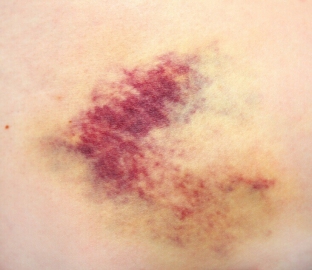Hematomas with extensive dimensions can disrupt the functioning of internal organs, form scar tissue, suppurate and provoke infection of surrounding tissues. If small hematomas, as a rule, resolve on their own, depending on the place of their formation, then extensive hematomas are subject to surgical intervention. Removal of a hematoma requires increased attention from the doctor, since with its extensive size or deep location there is a risk of damaging nearby tendons, vessels, tissues.
Why do hematomas occur and what types are there
Hematomas are accumulations of blood – liquid or clotted, which was formed due to damage to a blood vessel and was localized under the skin or mucous membrane. Sometimes hematomas occur in the thickness of the muscles, there are hematomas in the walls of various internal organs and even in the brain.
The main cause of a vessel rupture and blood flowing out of it is most often trauma (bruise, pinching, pressure), but the vessel can also be damaged due to weakness, fragility & nbsp; its walls, violations of their permeability. The cause of extravascular hemorrhage and hematoma formation may be poor blood clotting.
Most often, patients with subcutaneous hematomas turn to doctors, as they are clearly visible and cause concern. Hematomas in a mild form form within a day and cause moderate pain at the site of injury. Usually it is small, does not interfere with the functions of the body & nbsp; and gradually resolves on its own.
Medium-sized hematomas form approximately 5 hours after the injury, disturb the patient with swelling and soreness, sometimes with a violation of the motor functions of the part of the body where they are located. Severe hematomas can be seen a couple of hours after the bruise. They are characterized by severe pain and swelling. The functions of the limb affected by such a bruise are noticeably impaired.
Factors that may increase the risk of hematoma infection
With extensive hematomas, and sometimes with small ones, there is a risk of suppuration, which increases with:
- reduced body defenses;
- old age;
- impaired immunity;
- chronic diseases.
Symptoms of hematoma and basic principles of treatment
 The first signs of hematoma – This is reddening of the skin at the site of injury, the formation of a dense swelling that causes pain when touched. The color of the skin gradually changes to cyanotic, after a few days the hematomas become yellowish, and then greenish.
The first signs of hematoma – This is reddening of the skin at the site of injury, the formation of a dense swelling that causes pain when touched. The color of the skin gradually changes to cyanotic, after a few days the hematomas become yellowish, and then greenish.
If the hematoma is located in the muscle, then the swelling is poorly palpable, and instead of local edema, the entire limb may increase in volume. With a favorable outcome, hematomas resolve on their own after 5-7 days. If the hematomas are extensive, deep, a cavity filled with blood forms in their place. Clotted blood in the cavity can interfere with movements, disrupt the work of nearby organs and vessels. An infection can get into this cavity and cause suppuration, which is dangerous for its spread to neighboring tissues and the development of purulent complications.
Extensive and deep hematomas must be opened, cleaned, drained. Removal of a hematoma is most often performed on an outpatient basis, if there was an infection or a large hematoma was removed, antibiotic therapy is prescribed.







Add a comment